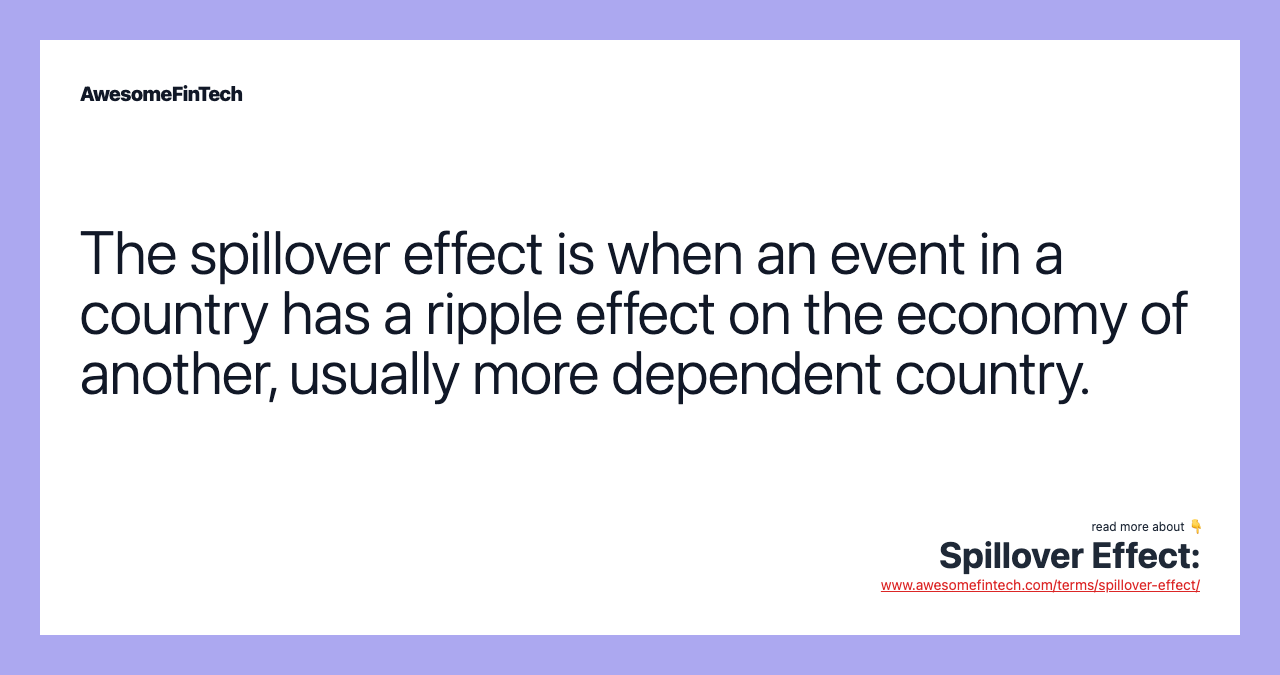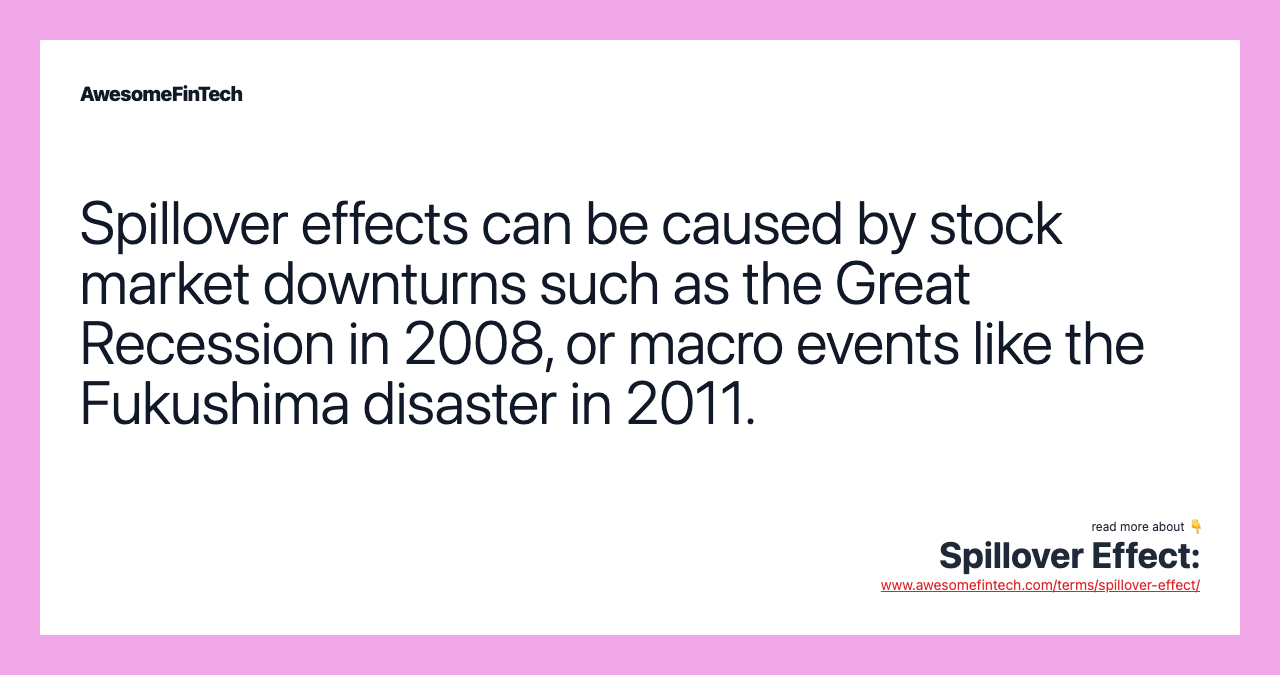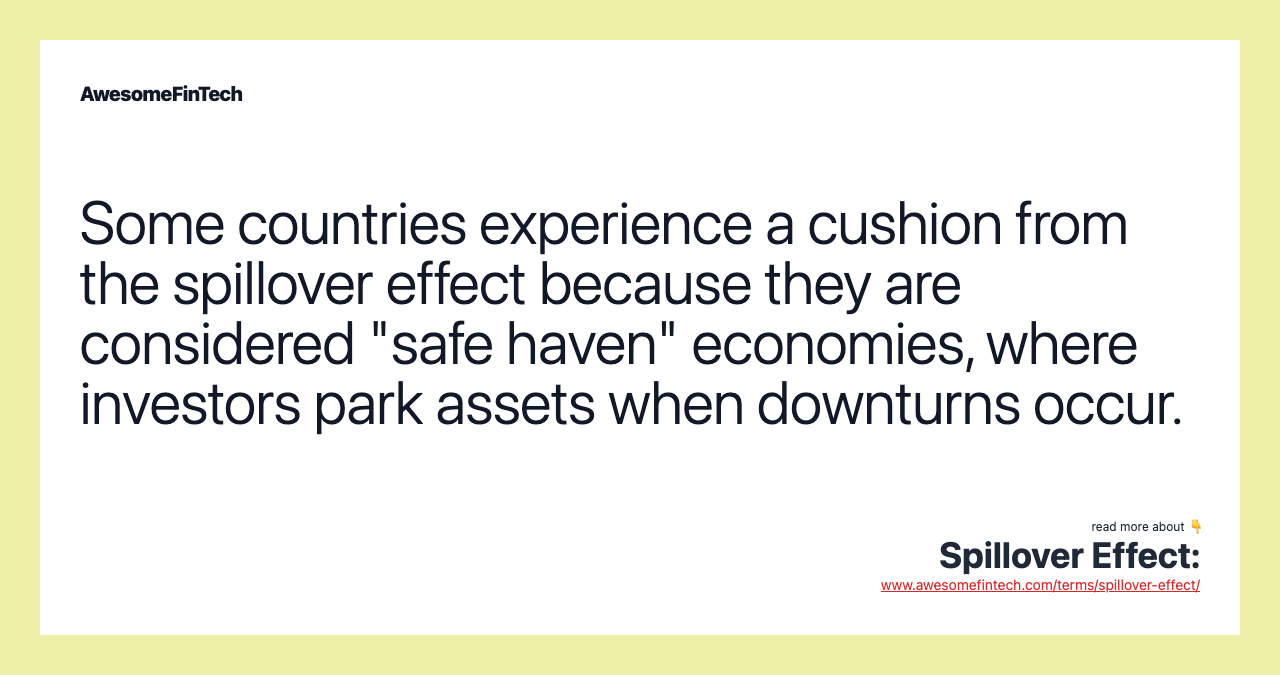Spillover Effect:
Spillover effect refers to the impact that seemingly unrelated events in one nation can have on the economies of other nations. Japan, the U.S., and the Eurozone, for example, all experience spillover effects from China, but this impact is partially counteracted by the flight to safety by investors into their respective markets when global markets get shaky. Most of the world experiences significant spillover effects when there is a downturn or macro effect in the world's two largest economies: the United States and China. With China becoming the number two economy in the world after the U.S., the number of countries that experience spillover effects from a Chinese slowdown is significant. For example, if consumer spending in the United States declines, it has spillover effects on the economies that depend on the U.S. as their largest export market.

More in Economy
What Is the Spillover Effect?
Spillover effect refers to the impact that seemingly unrelated events in one nation can have on the economies of other nations. Although there are positive spillover effects, the term is most commonly applied to the negative impact a domestic event has on other parts of the world such as an earthquake, stock market crisis, or another macro event.



How the Spillover Effect Works
Spillover effects are a type of network effect that increased since globalization in trade and stock markets deepened the financial connections between economies. The Canada-U.S. trade relationship provides an example of spillover effects. This is because the U.S. is Canada’s main market by a wide margin across nearly every export-oriented sector. The effects of a minor U.S. slowdown are amplified by the Canadian reliance on the U.S. market for its own growth.
For example, if consumer spending in the United States declines, it has spillover effects on the economies that depend on the U.S. as their largest export market. The larger an economy is, the more spillover effects it is likely to produce across the global economy. Since the U.S. is a leader in the global economy, nations and markets can be easily swayed by domestic turmoil.
Most of the world experiences significant spillover effects when there is a downturn or macro effect in the world's two largest economies: the United States and China.
Since 2009, China has emerged as a major source of spillover effects as well. This is because Chinese manufacturers have driven much of the global commodity demand growth since 2000. With China becoming the number two economy in the world after the U.S., the number of countries that experience spillover effects from a Chinese slowdown is significant.
When China's economy experiences a downturn, it has a palpable impact on the worldwide trade in metals, energy, grains, and many more commodities. This leads to economic pain through much of the world, although it is most acute in Eastern Europe, the Middle East, and Africa, as these areas rely on China for a larger percentage of their revenue.
Special Considerations
Unconnected Economies
There are some countries that experience very little as far as spillover effects from the global market. These closed-off economies are getting rarer as even North Korea — an economy nearly sealed off from world trade in 2019 — has begun to feel the spillover effects from intermittent Chinese slowdowns.
Safe-Haven Economies
A few developed economies are vulnerable to certain economic phenomena that can overwhelm spillover effects, no matter how strong. Japan, the U.S., and the Eurozone, for example, all experience spillover effects from China, but this impact is partially counteracted by the flight to safety by investors into their respective markets when global markets get shaky.
Similarly, if one of the economies in this safe haven group is struggling, investments will usually go to one of the remaining safe havens.
This effect was seen with the U.S. investment inflows during the EU’s struggles with the Greek debt crisis in 2015. When dollars flow into U.S. Treasuries, the yield goes down along with the borrowing cost for American homebuyers, borrowers, and businesses. This is an example of a positive spillover effect from the perspective of a U.S. consumer.
Related terms:
Commodity
A commodity is a basic good used in commerce that is interchangeable with other goods of the same type. read more
Consumer Spending
Consumer spending is the amount of money spent on consumption goods in an economy. read more
Creditor Nation
A creditor nation has positive net investment after recording all of the financial transactions completed between it and the rest of the world. read more
Economics : Overview, Types, & Indicators
Economics is a branch of social science focused on the production, distribution, and consumption of goods and services. read more
European Sovereign Debt Crisis
The European debt crisis refers to the struggle faced by Eurozone countries in paying off debts they had accumulated over decades. It began in 2008 and peaked between 2010 and 2012. read more
Gross Domestic Product (GDP)
Gross domestic product (GDP) is the monetary value of all finished goods and services made within a country during a specific period. read more
Inflation
Inflation is a decrease in the purchasing power of money, reflected in a general increase in the prices of goods and services in an economy. read more
Mature Economy
A mature economy is the economy of a nation with a stable population and slowing economic growth. read more
Network Effect
The network effect is a phenomenon where a good or service becomes more valuable when more people use it. Read how the network effect helps companies grow. read more
Safe Haven
A safe haven is an investment that is expected to retain its value, or even increase in value, during times of market turbulence. read more